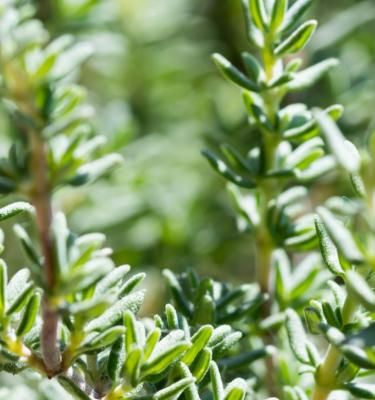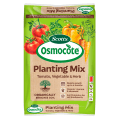

How to Grow A Thyme Plant
Thyme is a classic and flavourful, long lived herb used in many French, Italian, Mediterranean and Middle Eastern dishes. There are many different cultivars of thyme (Thymus) with different flavours and fragrances. The most widely planted is common thyme, but you’ll also find lemon thyme, orange thyme and even caraway thyme.
Thyme is a low growing, spreading plant that’s perfect to grow over the edges of a garden bed, in rockery gardens or in pots where it can cascade down the sides. Grow thyme in a full sun spot that gets regular water during the hottest months.
Top 5 steps to growing thyme
- Thyme plants need a full sun location
- Choose a spot that gets regular watering during the hottest months as thyme plants are fairly shallow rooted and can dry out easily.
- Harvest thyme sprigs year round when you need them for cooking or drying.
- Prune back thyme plants after flowering to encourage new growth
- Fertilise thyme plants with Scotts Osmocote® Controlled Release Fertiliser: Tomato, Vegetable & Herb in spring.
Essential shopping list for growing thyme
- Thyme seeds or potted plants
- Scotts Osmocote® Compost Premium Soil Improver
- Scotts Osmocote® Controlled Release Fertiliser: Tomato, Vegetable & Herb
- If growing in pots, Scotts Osmocote® Plus Organics Tomato, Vegetable & Herb Potting Mix and a suitable pot
- If growing from seeds, Scotts Osmocote® Seed & Cutting Mix and small pots or punnets.
- Garden trowel
- Mulch
- Defender Slug & Snail Pellets
Prepare
Thyme is most commonly grown from seeds or potted plants. Choose a full sun spot, that can easily be watered during the hottest months of the year.
Dig the hole twice as wide as the original nursery pot and the same depth. Mix a small amount of Scotts Osmocote® Compost Premium Soil Improver through the original soil at the base of the planting hole.
Growing thyme in the garden
Plant your thyme into prepared soil. Water it in well and mulch around the plant to retain moisture and suppress weeds.
Let the plant settle in for 30-60 days before harvesting. Thyme sprigs or leaves can be harvested using sharp scissors whenever you need. The leaves and flowers are both edible, they can be used in cooking or dried for storing.
How to grow thyme from seeds
To grow thyme from seed, sow thyme seeds in spring or summer (or March to September if you’re in a tropical region) — either directly into prepared garden soil or into pots filled with Scotts Osmocote® Seed & Cutting Mix. Sprinkle the seeds on the surface and lightly cover with soil or a potting mix - keep them moist while they germinate which should take 14-21 days.
If you’ve started thyme seeds in pots, transplant the seedlings into your prepared garden or larger pots filled with Scotts Osmocote® Plus Organics Tomato, Vegetable & Herb Potting Mix, once they’re 10-15cm tall, allowing 20-30cm between plants.
If you’ve direct sown thyme seeds into your garden, then thin to allow 20-30cm between plants.
Mulch new seedlings and allow them to grow unpicked for about 60-70 days so they can establish a healthy root system.
Planting thyme in pots
Thyme can be grown in small to medium pots with good drainage that are at least 30cm deep by 30cm wide.
Fill the pot with Scotts Osmocote® Plus Organics Tomato, Vegetable & Herb Potting Mix, before removing the thyme plant from its nursery pot and planting into the prepared pot. Backfill around the root ball and water in well.
Add a light layer of open organic mulch to retain moisture during the warmer months.
Thyme plant harvest & maintenance
Harvest thyme ‘sprigs’ when you need them - cutting them off using sharp scissors or secateurs. Regular harvesting will help keep the plant compact and neat. Both the leaves and flowers are edible and can be used fresh, added to cooking or even dried for storing.
After flowering use hedging shearers to prune off spent thyme flowers and tidy the plant up. If you live in cooler climate thyme may look a bit miserable over winter - give it a hard cut back in early spring to bring on lush new growth.
Thyme doesn’t need a lot of fertiliser, but will benefit from a dose of Scotts Osmocote® Controlled Release Fertiliser: Tomato, Vegetable & Herb in spring.
Common thyme plant pests & diseases
Thyme is rarely attacked by pests or diseases. The biggest problems may occur if the plants don’t have enough sunlight, the soil is waterlogged or the climate is too humid.
Make sure thyme is grown in areas with good drainage and full sun. If your thyme plants have good airflow around them and you avoid overhead watering - it can help reduce the risk of fungal problems caused by high humidity.
If slugs and snails become a problem use beer traps (saucers filled with beer) or sprinkle Defender Slug & Snail Pellets around your plants.




